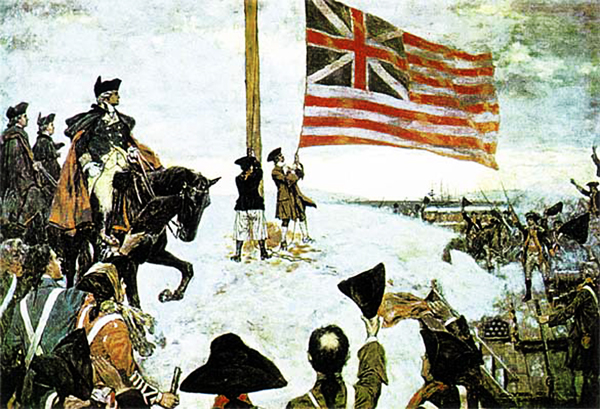
General George Washington hoists the first United States flag, the Grand Union Flag, at Prospect Hill on January 01, 1776
General George Washington hoists the first United States flag, the Grand Union Flag, at Prospect Hill: On January 01, 1776, the Continental Army was reorganized in accordance with a Congressional resolution which placed American forces under George Washington's control. On that New Year's Day the Continental Army was laying siege to Boston which had been taken over by the British Army. Washington ordered the Grand Union flag hoisted above his base at Prospect Hill “in compliment of the United Colonies”.
In Boston, on that New Year's Day, the Loyalists (supporters of Britain) had been circulating a recent King George speech, offering the Continental forces favorable terms if they laid down their arms.
These Loyalists were convinced that the King's speech had impressed the Continentals into surrendering - as a sign of the Continentals' “surrender”, the Loyalists mistook the flying of the Grand Union flag over Prospect Hill as a show of respect to King George.
In fact, however, the Continentals knew nothing of the speech until later. Washington wrote in a letter dated January 4:
“By this time, I presume, they begin to think it strange we have not made a formal surrender of our lines.”
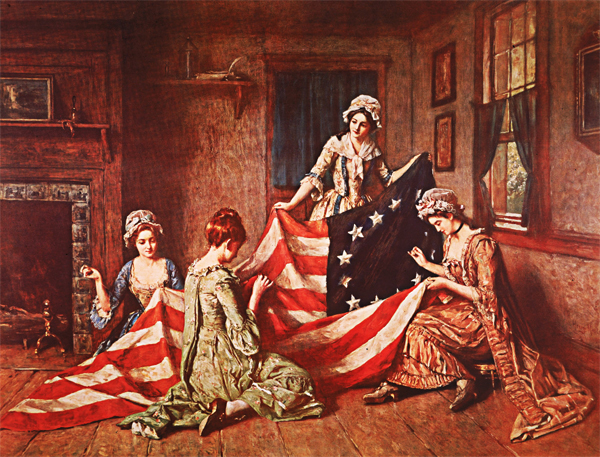
Obviously a new flag was needed.
According to Betsy Ross's dates and sequence of events, in May the Congressional Committee called upon her at her shop. She finished the flag either in late May or early June 1776. In July, the Declaration of Independence was read aloud for the first time at Independence Hall. Amid celebration, bells throughout the city tolled, heralding the birth of a new nation.
Much suffering and loss of life would result, however, before the United States would completely sever ties with Britain. Betsy Ross herself lost two husbands to the Revolutionary War. During the conflict the British appropriated her house to lodge soldiers. Through it all she managed to run her own upholstery business (which she continued operating for several decades after the war) and after the soldiers left, she wove cloth pouches which were used to hold gunpowder for the Continentals. (See The Story of Betsy Ross's Life for more information.)
(See “The Story of Betsy Ross's Life” for more information.)
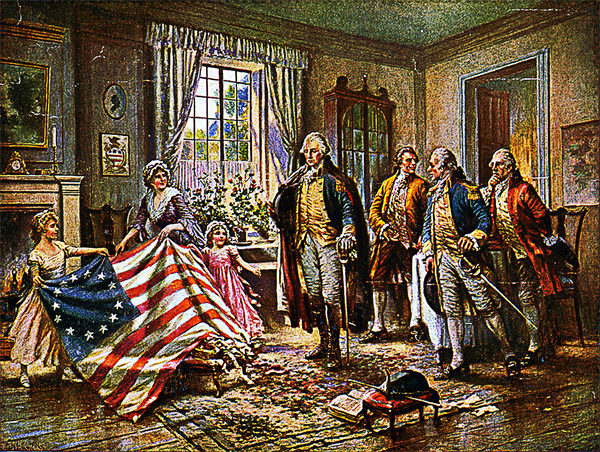
On June 14, 1777, the Continental Congress, seeking to promote national pride and unity, adopted the national flag.
“Resolved: that the flag of the United States be thirteen stripes, alternate red and white; that the union be thirteen stars, white in a blue field, representing a new constellation.”
United States History.org / Wikipedia / Encyclopedia Britannica / Encyclopedia Britannica /
Massachusetts Historical Society.org / North American Vexillological Association (NAVA).org / U.S. Government Information.gov / Mulder Media /
General George Washington hoists the first United States flag, the Grand Union Flag, at Prospect Hill on January 01, 1776 (YouTube) 

New Year’s festivities begin on December 31 (New Year’s Eve), the last day of the Gregorian calendar
New Year’s festivities begin: Civilizations around the world have been celebrating the start of each new year for at least four millennia. Today, most New Year’s festivities begin on December 31 (New Year’s Eve), the last day of the Gregorian calendar, and continue into the early hours of January 01 (New Year’s Day). Common traditions include attending parties, eating special New Year’s foods, making resolutions for the new year and watching fireworks displays.
Early New Year’s Celebrations
The earliest recorded festivities in honor of a new year’s arrival date back some 4,000 years to ancient Babylon. For the Babylonians, the first new moon following the vernal equinox—the day in late March with an equal amount of sunlight and darkness—heralded the start of a new year. They marked the occasion with a massive religious festival called Akitu (derived from the Sumerian word for barley, which was cut in the spring) that involved a different ritual on each of its 11 days. In addition to the new year, Atiku celebrated the mythical victory of the Babylonian sky god Marduk over the evil sea goddess Tiamat and served an important political purpose: It was during this time that a new king was crowned or that the current ruler’s divine mandate was symbolically renewed.
Throughout antiquity, civilizations around the world developed increasingly sophisticated calendars, typically pinning the first day of the year to an agricultural or astronomical event. In Egypt, for instance, the year began with the annual flooding of the Nile, which coincided with the rising of the star Sirius. The first day of the Chinese new year, meanwhile, occurred with the second new moon after the winter solstice.
In order to realign the Roman calendar with the sun, Julius Caesar had to add 90 extra days to the year 46 B.C. when he introduced his new Julian calendar.
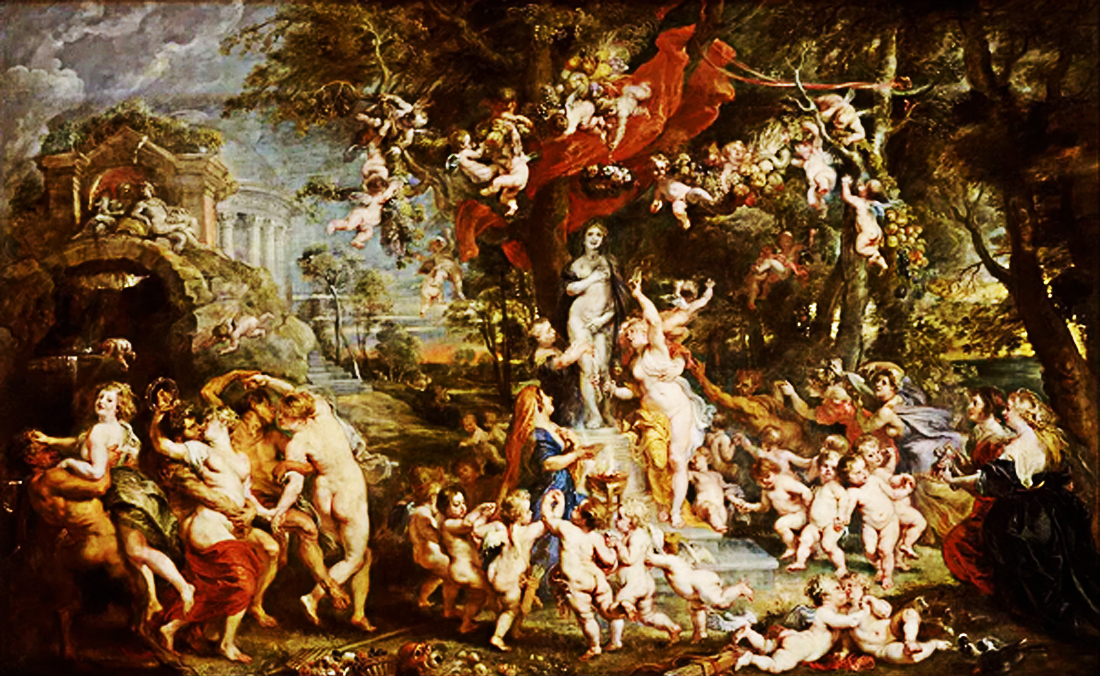
January 1st Becomes New Year’s Day
The early Roman calendar consisted of 10 months and 304 days, with each new year beginning at the vernal equinox; according to tradition, it was created by Romulus, the founder of Rome, in the eighth century B.C. A later king, Numa Pompilius, is credited with adding the months of Januarius and Februarius. Over the centuries, the calendar fell out of sync with the sun, and in 46 B.C. the emperor Julius Caesar decided to solve the problem by consulting with the most prominent astronomers and mathematicians of his time. He introduced the Julian calendar, which closely resembles the more modern Gregorian calendar that most countries around the world use today.
As part of his reform, Caesar instituted January 01 as the first day of the year, partly to honor the month’s namesake: Janus, the Roman god of beginnings, whose two faces allowed him to look back into the past and forward into the future. Romans celebrated by offering sacrifices to Janus, exchanging gifts with one another, decorating their homes with laurel branches and attending raucous parties. In medieval Europe, Christian leaders temporarily replaced January 01 as the first of the year with days carrying more religious significance, such as December 25 (the anniversary of Jesus’ birth) and March 25 (the Feast of the Annunciation); Pope Gregory XIII reestablished January 01 as New Year’s Day in 1582.

New Year’s Traditions
In many countries, New Year’s celebrations begin on the evening of December 31 - New Year’s Eve - and continue into the early hours of January 01. Revelers often enjoy meals and snacks thought to bestow good luck for the coming year. In Spain and several other Spanish-speaking countries, people bolt down a dozen grapes-symbolizing their hopes for the months ahead-right before midnight.
In many parts of the world, traditional New Year’s dishes feature legumes, which are thought to resemble coins and herald future financial success; examples include lentils in Italy and black-eyed peas in the southern United States. Because pigs represent progress and prosperity in some cultures, pork appears on the New Year’s Eve table in Cuba, Austria, Hungary, Portugal and other countries. Ring-shaped cakes and pastries, a sign that the year has come full circle, round out the feast in the Netherlands, Mexico, Greece and elsewhere. In Sweden and Norway, meanwhile, rice pudding with an almond hidden inside is served on New Year’s Eve; it is said that whoever finds the nut can expect 12 months of good fortune.
Other customs that are common worldwide include watching fireworks and singing songs to welcome the new year, including the ever-popular “Auld Lang Syne“ in many English-speaking countries. The practice of making resolutions for the new year is thought to have first caught on among the ancient Babylonians, who made promises in order to earn the favor of the gods and start the year off on the right foot. (They would reportedly vow to pay off debts and return borrowed farm equipment.)
In the United States, the most iconic New Year’s tradition is the dropping of a giant ball in New York City’s Times Square at the stroke of midnight. Millions of people around the world watch the event, which has taken place almost every year since 1907. Over time, the ball itself has ballooned from a 700-pound iron-and-wood orb to a brightly patterned sphere 12 feet in diameter and weighing in at nearly 12,000 pounds. Various towns and cities across America have developed their own versions of the Times Square ritual, organizing public drops of items ranging from pickles (Dillsburg, Pennsylvania) to possums (Tallapoosa, Georgia) at midnight on New Year’s Eve.
History.com / Wikipedia / Encyclopedia Britannica / Ancient Origins / Live Science /
New Year’s festivities begin on December 31 (New Year’s Eve), the last day of the Gregorian calendar (YouTube) 
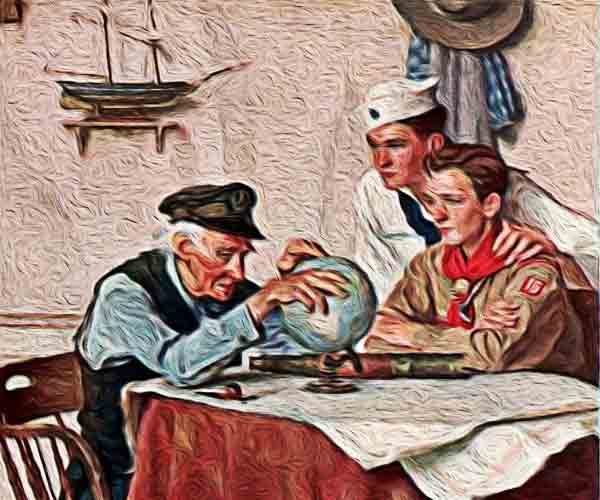
Understanding Military Terminology
Ready Reserve
(DOD) The Selected Reserve and Individual Ready Reserve liable for active duty as prescribed by law (Title 10, United States Code, Sections 10142, 12301, and 12302).
See also Active Duty; Individual Ready Reserve; Selected Reserve.
Joint Publications (JP 4-05) Joint Mobilization Planning
Ready-To-Load Date
(DOD) The date when a unit will be ready to move from the origin, i.e., mobilization station.
Also called RLD.
Joint Publications (JP 5-0) Joint Planning, 01 December 2020
Realistic Military Training
(DOD) Department of Defense training conducted off federal property utilizing private or non-federal public property and infrastructure.
Joint Publications (DODI 1322.28) Executive Services Directorate
Real Property
(DOD) Lands, buildings, structures, utilities systems, improvements, and appurtenances, thereto that includes equipment attached to and made part of buildings and structures, but not movable equipment.
See also National Military Strategy.
Joint Publications (JP 3-34) Joint Engineer Operations
Joint Publication - Department of Defense Dictionary of Military and Associated Terms
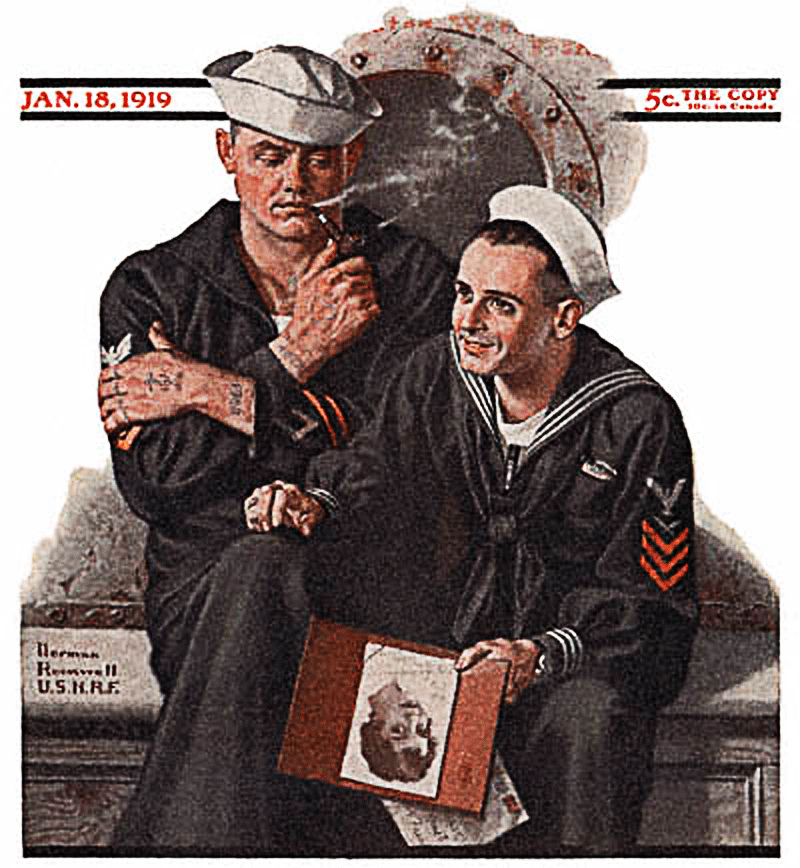
The Old Salt’s Corner
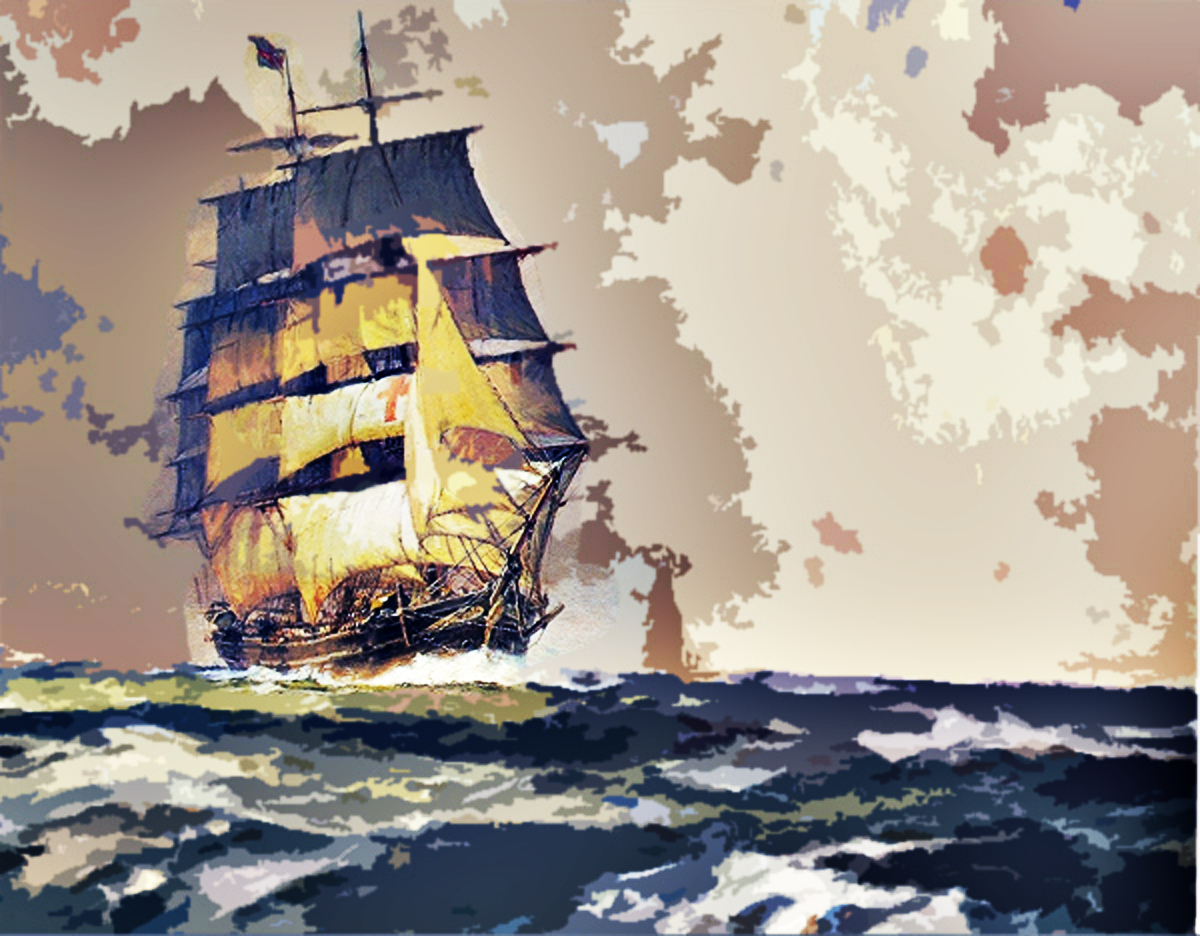
I must go down to the seas again, to the lonely sea and the sky,
And all I ask is a tall ship and a star to steer her by,
And the wheel's kick and the wind's song and the white sail's shaking,
And a gray mist on the sea's face, and a gray dawn breaking.
I must go down to the seas again, for the call of the running tide
Is a wild call and a clear call that may not be denied;
And all I ask is a windy day with the white clouds flying,
And the flung spray and the blown spume, and the sea-gulls crying..
I must go down to the seas again, to the vagrant gypsy life,
To the gull's way and the whale's way, where the wind's like a whetted knife;
And all I ask is a merry yarn from a laughing fellow-rover,
And quiet sleep and a sweet dream when the long trick's over.
~ John Masefield

“I’m Just Sayin”
“Nature never did betray the heart that loved her.”
“To me the meanest flower that blows can give thoughts that do often lie too deep for tears.”
“The flower that smells the sweetest is shy and lowly.”
“The ocean is a mighty harmonist.”
“A simple child that lightly draws it's breath and feels its life in every limb.
What should it know of death?.”
“What we need is not the will to believe,
but the wish to find out.”
“That though the radiance which was once so bright be now forever taken from my sight.
Though nothing can bring back the hour of splendor in the grass,
glory in the flower.
We will grieve not,
rather find strength in what remains behind.”
“Life is divided into three terms -
that which was,
which is,
and which will be.
Let us learn from the past to profit by the present,
and from the present,
To live better in the future.”
~ William Wordsworth

“Thought for the Day”
“A man is what he thinks about all day long.”
“All I have seen teaches me to trust the creator for all I have not seen.”
“The greatest glory in living lies not in never falling,
but in rising every time we fall.”
“For every minute you remain angry,
You give up sixty seconds of peace of mind.”
“What lies behind you and what lies in front of you,
pales in comparison to what lies inside of you.”
“The greatest glory in living lies not in never falling,
but in rising every time we fall.”
“Though we travel the world over to find the beautiful,
we must carry it with us or we find it not.”
~ Ralph Waldo Emerson

“What I Learned”
“Success usually comes to those who are too busy to be looking for it.”
“This world is but a canvas to our imagination.”
“Heaven is under our feet as well as over our heads.”
“Many men go fishing all of their lives without knowing that it is not fish they are after.”
“The price of anything is the amount of life you exchange for it.”
“There are a thousand hacking at the branches of evil to one who is striking at the root.”
“It's not what you look at that matters,
it's what you see.”
“Disobedience is the true foundation of liberty.
The obedient must be slaves.”
~ Henry David Thoreau
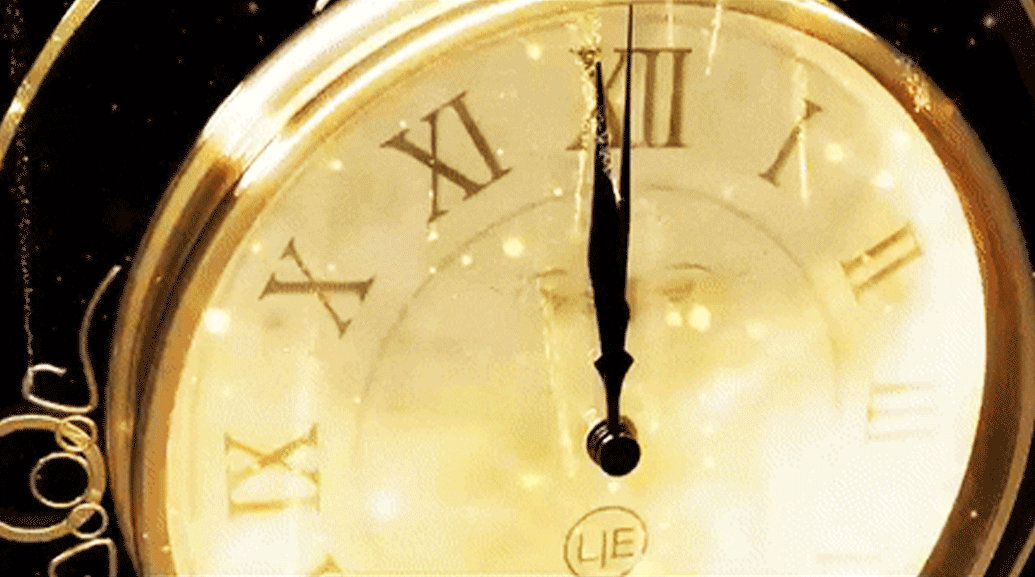
Mr. Answer Man Please Tell Us: The Origins of New Year’s Celebrations
On the 1st January of every year, many countries around the world celebrate the beginning of a new year. But there is nothing new about New Year’s. In fact, festivals and celebrations marking the beginning of the calendar have been around for thousands of years. While some festivities were simply a chance to drink and be merry, many other New Year celebrations were linked to agricultural or astronomical events. In Egypt, for instance, the year began with the annual flooding of the Nile, which coincided with the rising of the star Sirius. The Phoenicians and Persians began their new year with the spring equinox, and the Greeks celebrated it on the winter solstice. The first day of the Chinese New Year, meanwhile, occurred with the second new moon after the winter solstice.
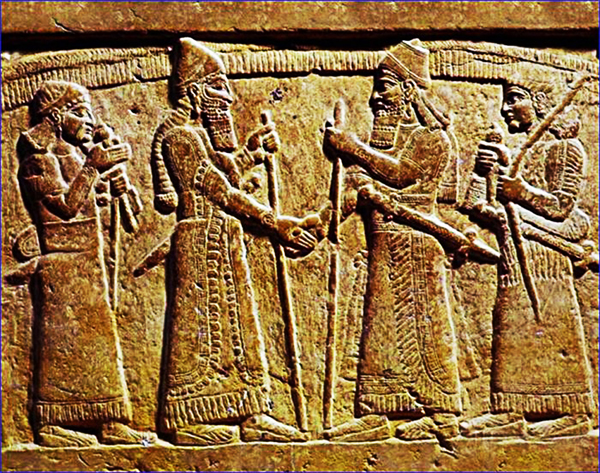
The Celebration of Akitu in Babylon
The earliest recorded New Year’s festivity dates back some 4,000 years to ancient Babylon, and was deeply intertwined with religion and mythology. For the Babylonians of ancient Mesopotamia, the first new moon following the vernal equinox—the day in late March with an equal amount of sunlight and darkness—heralded the start of a new year and represented the rebirth of the natural world. They marked the occasion with a massive religious festival called Akitu (derived from the Sumerian word for barley, which was cut in the spring) that involved a different ritual on each of its 11 days. During the Akitu, statues of the gods were paraded through the city streets, and rites were enacted to symbolize their victory over the forces of chaos. Through these rituals the Babylonians believed the world was symbolically cleansed and recreated by the gods in preparation for the new year and the return of spring.
In addition to the new year, Atiku celebrated the mythical victory of the Babylonian sky god Marduk over the evil sea goddess Tiamat and served an important political purpose: it was during this time that a new king was crowned or that the current ruler’s divine mandate was renewed. One fascinating aspect of the Akitu involved a kind of ritual humiliation endured by the Babylonian king. This peculiar tradition saw the king brought before a statue of the god Marduk, stripped of his royal regalia, slapped and dragged by his ears in the hope of making him cry. If royal tears were shed, it was seen as a sign that Marduk was satisfied and had symbolically extended the king’s rule.
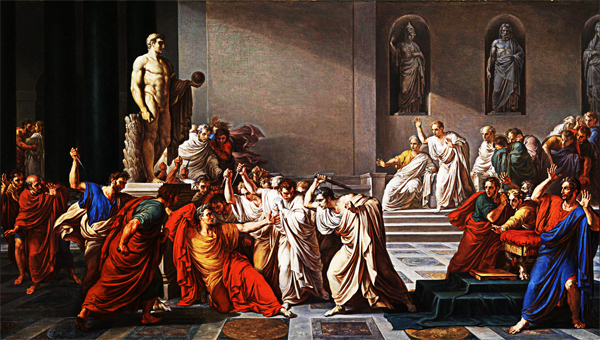
Ancient Roman Celebration of Janus
The Roman New Year also originally corresponded with the vernal equinox. The early Roman calendar consisted of 10 months and 304 days, with each new year beginning at the vernal equinox. According to tradition, the calendar was created by Romulus, the founder of Rome, in the eighth century B.C. However, over the centuries, the calendar fell out of sync with the sun, and in 46 B.C. the emperor Julius Caesar decided to solve the problem by consulting with the most prominent astronomers and mathematicians of his time. He introduced the Julian calendar, a solar-based calendar which closely resembles the more modern Gregorian calendar that most countries around the world use today.
As part of his reform, Caesar instituted January 1 as the first day of the year, partly to honour the month’s namesake: Janus, the Roman god of change and beginnings, whose two faces allowed him to look back into the past and forward into the future. This idea became tied to the concept of transition from one year to the next.
Romans would celebrate January 1st by offering sacrifices to Janus in the hope of gaining good fortune for the New Year, decorating their homes with laurel branches and attending raucous parties. This day was seen as setting the stage for the next twelve months, and it was common for friends and neighbours to make a positive start to the year by exchanging well wishes and gifts of figs and honey with one another.
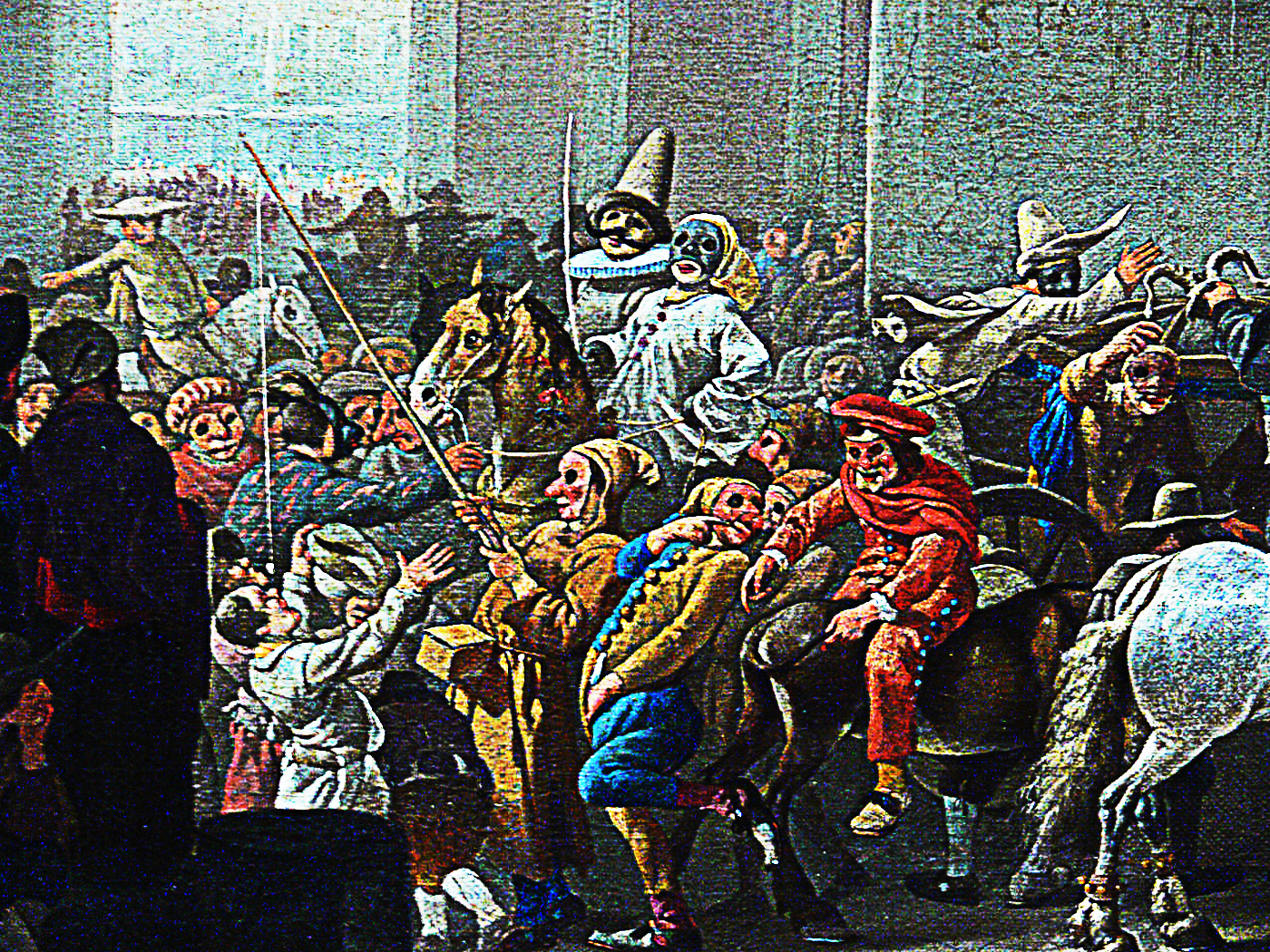
Middle Ages: January 1st Abolished
In medieval Europe, however, the celebrations accompanying the New Year were considered pagan and unchristian-like, and in 567 AD the Council of Tours abolished January 1st as the beginning of the year, replacing it with days carrying more religious significance, such as December 25th or March 25 th, the Feast of the Annunciation, also called “Lady Day”.
The date of January 1st was also given Christian significance and became known as the Feast of the Circumcision, considered to be the eighth day of Christ's life counting from December 25th and following the Jewish tradition of circumcision eight days after birth on which the child is formally given his or her name. However, the date of December 25th for the birth of Jesus is debatable.
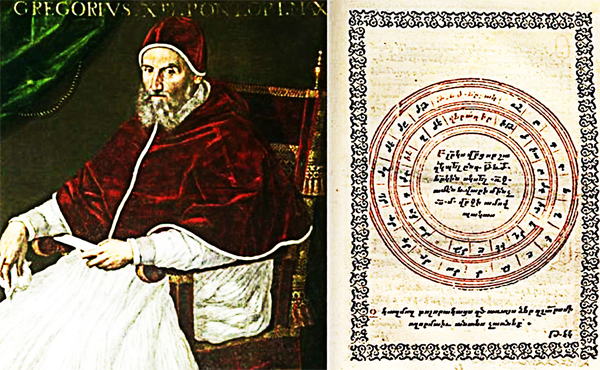
Gregorian Calendar: January 1st Restored
In 1582, after reform of the Gregorian calendar, Pope Gregory XIII re-established January 1st as New Year’s Day. Although most Catholic countries adopted the Gregorian calendar almost immediately, it was only gradually adopted among Protestant countries. The British, for example, did not adopt the reformed calendar until 1752. Until then, the British Empire, and their American colonies, still celebrated the New Year in March.
Ancient History Encyclopedia.eu / Wikipedia / Encyclopedia Britannica /
History Channel / Psychology Today / Live Science / Earth Sky.org / Quora /
The Origins of New Year’s Celebrations (YouTube) 

Mr. Answer Man Please Tell Us: Why Do Fruitcakes Last So Long?
Fruitcake is a shelf-stable food unlike any other. One Ohio family has kept the same fruitcake uneaten (except for periodic taste tests) since it was baked in 1878. In Antarctica, a century-old fruitcake discovered in artifacts left by explorer Robert Falcon Scott’s 1910 expedition remains “almost edible”, according to the researchers who found it. So what is it that makes fruitcake so freakishly hardy?
It comes down to the ingredients. Fruitcake is notoriously dense. Unlike almost any other cake, it’s packed chock-full of already-preserved foods, like dried and candied nuts and fruit. All those dry ingredients don’t give microorganisms enough moisture to reproduce, as Ben Chapman, a food safety specialist at North Carolina State University, explained in 2014. That keeps bacteria from developing on the cake.
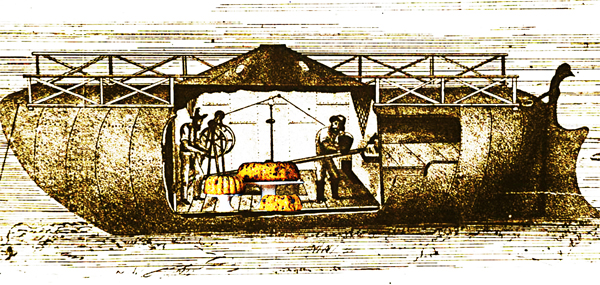
Booze helps. A good fruitcake involves plenty of alcohol to help it stay shelf-stable for years on end. Immediately after a fruitcake cools, most bakers will wrap it in a cheesecloth soaked in liquor and store it in an airtight container. This keeps mold and yeast from developing on the surface. It also keeps the cake deliciously moist.
Fruitcakes aren’t just capable of surviving unspoiled for months on end; some people contend they’re better that way. Fruitcake fans swear by the aging process, letting their cakes sit for months or even years at a stretch. Like what happens to a wine with age, this allows the tannins in the fruit to mellow, according to the Wisconsin bakery Swiss Colony, which has been selling fruitcakes since the 1960s. As it ages, it becomes even more flavorful, bringing out complex notes that a young fruitcake (or wine) lacks.
If you want your fruitcake to age gracefully, you’ll have to give it a little more hooch every once in a while. If you’re keeping it on the counter in advance of a holiday feast a few weeks away, the King Arthur Flour Company recommends unwrapping it and brushing it with whatever alcohol you’ve chosen (brandy and rum are popular choices) every few days. This is called “feeding” the cake, and should happen every week or so.
Honestly, it would probably taste OK if you let it sit in brandy for a few days.
Smithsonian / Wikipedia / Encyclopedia Britannica / Daily Mail / National Geographic /
Quora / Mental Floss /
Why Do Fruitcakes Last So Long? (YouTube) 

NAVSPEAK aka U.S. Navy Slang
Titivate: To spruce up or clean up the ship and its company.
Titless Wave: Male clerical personnel such as yeomen, storekeepers, personnelmen, and other desk jockeys, pencil pushers, etc. See “Sea Pussy”.
Tits Machine:: Old-school term for a kick-ass aircraft, usually a fighter, that consisted of little more than an airframe, minimal avionics, and a huge engine or two./p>
The beak of the eagle can be used as an emergency bottle opener.
Crusader was universally accepted as a tits machine.
The F-14 Tomcat was also widely accepted.
Today's modern electronic video game fighters like the F/A-18 will never be in the same ballpark.
Tits Up: Broke-dick, inoperable, dead (from some piece of equipment being “flat on its back”). Sometimes referred to as “Tango Uniform”
TLD (Nuclear): Thermo-Luminescent Dosimeter. More Affectionately “Tiny Little Dick”.
Worn by nukes and submarine crewmembers to measure radiation received over time.
Often a good source of humor for when the topsiders ask what they are for.
Tonkin Gulf Yacht Club: Those elements of the Pacific Fleet which operated in the referenced waters 1965-1975.
Topsider: Anyone who is not a nuke, or Engineer. On other surface ships.
Torpedo Sponge: Similar to “Missile Sponge”, this refers to the smaller ships in a convoy, whose duty it is to protect the carrier, to the point of taking the torpedo hit for the carrier if needed.
Wiktionary.org

Just for you MARINE
T/O&E: Table of Organization and Equipment as defined by MCO 5311.1E Total Force Structure Process,
is a list authorizing a unit the personnel of a particular rank and MOS,
as well as organic equipment required to accomplish the unit's assigned Mission Essential Tasks:
often presented separately as T/O and T/E.
Top: Informal nickname for a Master Sergeant or Master Gunnery Sergeant, inappropriate to use without permission.
Topside: Ship's upper deck.
Tore up: Broken, messy, unserviceable.
Wikipedia.org

Naval Aviation Squadron Nicknames
HT-8 Helicopter Training (HT) Squadron EIGHT - nicknamed the “Eightballers”
United States Navy - Marine Corps Commander, Helicopter Training Air Wing FIVE - Naval Air Station Milton, Florida. / HTU-1: December 3, 1950-March 1957 / HTG-1: March 1957- July 1, 1960 / HT-8: July 1, 1960 – present
Wikipedia.org

Where Did That Saying Come From?

“A little knowledge is a dangerous thing:”
Meaning: The proverb “A little knowledge is a dangerous thing” expresses the idea that a small amount of knowledge can mislead people into thinking that they are more expert than they really are, which can lead to mistakes being made.
History: “A little knowledge is a dangerous thing” and “a little learning is a dangerous thing” have been used synonymously since the 18th century.
The “little learning” version is widely attributed to Alexander Pope (1688 - 1744). It is found in his An Essay on Criticism, 1709 and I can find no earlier example of the expression in print:
A little learning is a dangerous thing;
drink deep, or taste not the Pierian spring:
there shallow draughts intoxicate the brain,
and drinking largely sobers us again.
The similarity of the two phrases is demonstrated by what appears to be an impromptu coining of “a little knowledge is a dangerous thing” in a piece in The monthly miscellany; or Gentleman and Lady's Complete Magazine, Vol II, 1774, in which the writer misquoted Pope:
Mr. Pope says, very truly, “A little knowledge is a dangerous thing.”
Both Pope's original verse and the misquotation of it were pre-dated by a similar notion expressed by an anonymous author, signing himself “A B”, in the collection of letters published in 1698 as The Mystery of Phanaticism:
“Twas well observed by my Lord Bacon, That a little knowledge is apt to puff up, and make men giddy, but a greater share of it will set them right, and bring them to low and humble thoughts of themselves.”

Again, there is a degree of misquotation here. 'My Lord Bacon' was the English politician and philosopher Francis Bacon, Viscount St Alban, and what he actually said, in his The Essays: Of Atheism, 1601, was:
“A little philosophy inclineth man’s mind to atheism; but depth in philosophy bringeth men’s minds about to religion.”
So, who coined the phrase? It appears to have been a group effort. Bacon can be credited with the idea, Pope with the “learning” version and the mysterious “A B” with the 'knowledge' version.
The number of writers who were stating variants of “a little learning is a dangerous thing” in early 18th England is probably a consequence of spread in the availability of scholarly works in English.
The Age of the Enlightenment, as the period was known, saw a growth in the interest of cultural and philosophical concerns amongst the middle classes.
Discussion of such topics had previously been conducted mainly in Latin and been the preserve of the elite.
The sight of the hoi-polloi having views on higher matters wasn't welcomed by those who had been classically schooled - hence “a little learning is a dangerous thing”.
Phrases.org.uk

Science & Technology

FEATURED: Study reveals an increase in the frequency of nuclear power outages caused by climate change
• NASA Mars rover begins collecting rock in search of alien life
Humans could recolonize Earth after mass extinctions with ectogenesis
• A test that detects COVID-19 variants in your spit
• Antibody findings spark ideas for pan-coronavirus vaccine
Potential COVID-19 medication found among tapeworm drugs
• A microRNA network is the putative mediator of reductive stress in the heart
• New metric shows COVID cut average lifespan by nearly a decade in parts of U.S.
Recycling a cell's energy centers to ward off Parkinson's disease
• One dose of Pfizer vaccine may be enough for folks who've had COVID: study
• New technology will allow important metals to be made more efficiently
Phys.org / MedicalXpress / TechXplore

FEATURED: Watch female dragonflies wrestle away unwanted males in mid-air
• COVID-19 vaccinemaker Novavax faces manufacturing setback
Soil maps help scientists dig up dirt in criminal investigations
• This scientist says cleaning indoor air could make us healthier - and smarter
Watch out, Olympic gymnasts: These squirrels have their own gold medal moves
• A giant trial of COVID-19 treatments is restarting. Here are the drugs it’s betting on
What does the Delta variant have in store for the United States? We asked coronavirus experts
• The overlooked superpower of mRNA vaccines
Science AAAS

Bizarre News (we couldn’t make up stuff this good - real news story)
Scientists transform water into shiny, golden metal
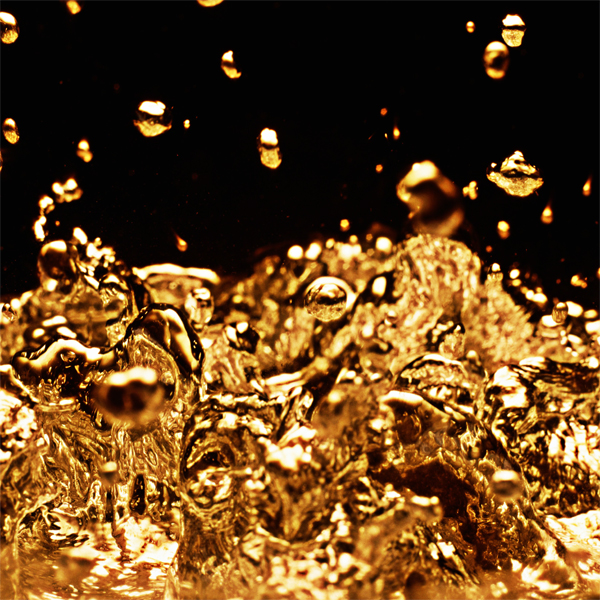
In a mind-mending experiment, scientists transformed purified water into metal for a few fleeting seconds, thus allowing the liquid to conduct electricity.
Unfiltered water can already conduct electricity - meaning negatively charged electrons can easily flow between its molecules - because unfiltered water contains salts, according to a statement about the new study. However, purified water contains only water molecules, whose outermost electrons remain bound to their designated atoms, and thus, they can't flow freely through the water.
Theoretically, if one applied enough pressure to pure water, the water molecules would squish together and their valence shells, the outermost ring of electrons surrounding each atom, would overlap. This would allow the electrons to flow freely between each molecule and would technically turn the water into a metal.

The problem is that, to squash water into this metallic state, one would need 15 million atmospheres of pressure (about 220 million psi), study author Pavel Jungwirth, a physical chemist at the Czech Academy of Sciences in Prague, told Nature News & Comment. For this reason, geophysicists suspect that such water-turned-metal might exist in the cores of huge planets like
Jupiter, Neptune and Uranus, according to Nature News.
But Jungwirth and his colleagues wondered whether they could turn water into metal through different means, without creating the ridiculous pressures found in Jupiter's core. They decided to use alkali metals, which include elements like sodium and potassium and hold only one electron in their valence shells. Alkali metals tend to “donate” this electron to other atoms when forming chemical bonds, because the “loss” of that lone electron makes the alkali metal more stable.
Alkali metals can explode when exposed to water, and Jungwirth and his colleagues have actually studied these dramatic reactions in the past, according to Cosmos Magazine. But they theorized that, if they could somehow avoid the explosion, they could borrow electrons from alkali metals and use those electrons to turn water metallic.

In their new experiment, described in a report published Wednesday (July 28) in the journal Nature, the team did just that.
In the experiment, they placed a syringe filled with sodium and potassium in a vacuum chamber, squeezed out small droplets of the metals, which are liquid at room-temperature, and then exposed said metal droplets to a tiny amount of water vapor. The water formed a 0.000003 inch (0.1 micrometer) film over the surface of the metal droplets, and immediately, electrons from the metals began rushing into the water.
For the experiment to work, the electrons had to move faster than an explosive reaction could take place, Jungwirth told Nature News. And once the electrons zoomed from the alkali metals to the water, an incredible thing happened: For a few short moments, the water turned a shiny, golden yellow color. Using spectroscopy, the team was able to show that the bright yellow water was in fact metallic.
“Our study not only shows that metallic water can indeed be produced on Earth, but also characterizes the spectroscopic properties associated with its beautiful golden metallic luster”, study author Robert Seidel, head of the Young Investigator Group at Humboldt University of Berlin, said in the statement. “You can see the phase transition to metallic water with the naked eye”, he added.
“It was amazing, like [when] you discover a new element”, Jungwirth told Nature News & Comment.
Related: The surprisingly strange physics of water
Liquid of life: Stats on how we use water (Infographic)
Where'd that bridge go? The 8 weirdest metal thefts
Wacky physics: The coolest little particles in nature
Live Science (07/30/2021) 


SONG FACTS

“Purple Haze”  - Jimi Hendrix
- Jimi Hendrix
Album: Are You Experienced?
Released 1967 
Hendrix claimed
“Purple Haze”  was inspired by a dream where he was walking under the sea. In the dream, he said a purple haze surrounded him, engulfed him and got him lost. It was a traumatic experience, but in his dream his faith in Jesus saved him.
was inspired by a dream where he was walking under the sea. In the dream, he said a purple haze surrounded him, engulfed him and got him lost. It was a traumatic experience, but in his dream his faith in Jesus saved him.
At one point, Hendrix wrote the chorus as “purple haze, Jesus saves”, but decided against it.
Part of the lyrics were formed from some of Jimi's free verse ramblings that he jotted down from time to time.
This song was written under the guidance of Hendrix' manager, ex-Animals bassist Chas Chandler. They had just released Hendrix' first single, a cover of Tim Rose's
“Hey Joe”  and were looking for a follow up. Chandler was impressed when he first heard the riff, and inspired Jimi to finish writing the song.
and were looking for a follow up. Chandler was impressed when he first heard the riff, and inspired Jimi to finish writing the song.
On the original recording, you hear the line up of the Experience with Noel Redding on bass and Mitch Mitchell on drums.
The opening chord of two riffs then an interval of flattened fifth is the d5 or “tritone”, which has long been regarded as the “Most imperfect of dissonances” and was generally avoided in composition for that reason
Hendrix claimed this had nothing to do with drugs, but it's hard to believe they weren't an influence. The lyrics seem to vividly portray an acid trip, and Hendrix was doing plenty of drugs at the time.
Jimi and producer Chas Chandler used some unusual studio tricks to get the unique sound. To create the background track that sounds distant, they put a pair of headphones around a microphone and recorded it that way to get an echo effect.
Hendrix wrote the lyrics on the day after Christmas in 1966. He wrote a lot more than what made it to the song. The track was developed at a press function that he attended at East London's Upper Cut Club, run by the former boxer Billy Walker. Hendrix launched into the scorching riff in the club's compact dressing room and every head turned. “I said, write the rest of that”, said Chandler. “That's the next single!” It was premiered live on January 8, 1967, in Sheffield in the north of England.
For one of the guitar tracks, Hendrix used a device called an Octavia, which could raise or lower the guitar by a full octave.
This contains one of the most misheard lyrics ever, with “Scuse me while I kiss the sky” interpreted as “Scuse me while I kiss this guy”. Hendrix added to the confusion by sometimes singing it that way and pointing to one of his band members.
A month before Hendrix died, he opened a recording studio in Greenwich Village called Electric Lady. One of the studios is known as “Purple Haze” and contains a purple mixing board. The studios have remained active with
The Clash, Weezer, Patti Smith and Alicia Keys all recording there at some point.
“Purple Haze”  is apparently referenced in an episode of
“The Simpsons”
is apparently referenced in an episode of
“The Simpsons”  . Homer is shopping (for useless garbage, of course) and finds a back massaging chair called the Spinemelter 2000. Homer sits in the chair and orders the store clerk to put it on full power. As the chair begins to massage Homer, he tells his family, “‘Scuse Me While I Miss the Sky”
. Homer is shopping (for useless garbage, of course) and finds a back massaging chair called the Spinemelter 2000. Homer sits in the chair and orders the store clerk to put it on full power. As the chair begins to massage Homer, he tells his family, “‘Scuse Me While I Miss the Sky”
When the recording was sent to Hendrix's American label, a note said, “deliberate distortion, do not correct.”
The track was the penultimate song Hendrix played in concert, on September 6, 1970, days before his death.
James Ford, who is a member of the production duo Simian Mobile Disco tells in the NME column “My first record”:
“The first record I remember really connecting with was ‘Purple Haze’. I remember being blown away by its wild and unhinged energy. It was also the first thing I ever tried to work out on a guitar. Needless to say, I didn't get very far at that age.”
MORE SONGS
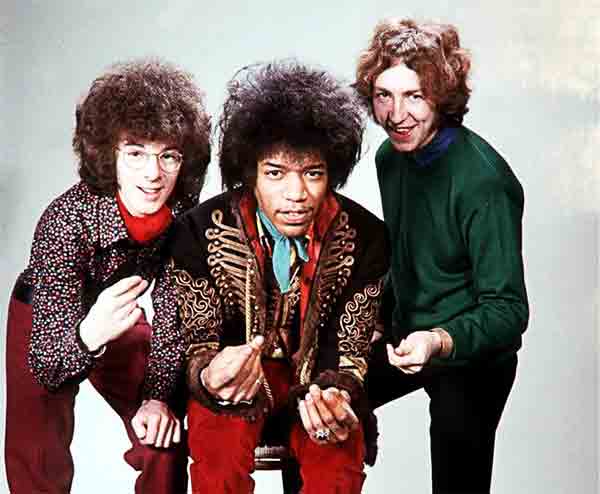
“Hey Joe” (1966) 
“Stone Free” (1966) 
“Foxy Lady” (1967) 
“The Wind Cries Mary” (1967) 
“Fire” (1967) 
“If 6 Was 9” (1967) 
“Here My Train A Cominc” (1967) 
“Little Wing” (1967) 
“Burning of the Midnight Lamp” (1967) 
“All Along the Watchtower” (1968) 
“Voodoo Child (Slight Return)” (1968) 
“Crosstown Traffic” (1968) 
“Gypsy Eyes” (1968) 
“Freedom” (1970) 
“Dolly Dagger” (1970) 
“Ezy Rider” (1970) 
“Freedom” (1970) 
Jimi Hendrix official site (Jimi Hendrix Discography) / Rock & Roll Hall of Fame / Billboard / All Music / Song Facts /
Ultimate Classic Rock / Jimi Hendrix
Image: “Are You Experienced? (album)” by Jimi Hendrix

Trivia
● What is tattooed on Popeye’s arm?
Answer to Trivia
● The 13 stripes on the United States Flag represent what?
Answer to Trivia
● What “imaginary” number is defined as the square root of -1?
Answer to Trivia
● What snack gave Mickey Mouse his first spoken words?
Answer to Trivia

A Test for People Who Know Everything
From the Jeopardy Archives Category - “PHARAOHS” ($200)
“The face of this statue of Giza is thought to represent Khafre, builder of one of the Great Pyramids at Giza.”
Answer to Jeopardy READ MORE: World History.org
From the Jeopardy Archives Category - “PHARAOHS” ($400)
“The word pharaoh originally referred to a palace, but in the 18th of these, the word began to refer to the kings themselves.”
Answer to Jeopardy READ MORE: World History.org
From the Jeopardy Archives Category - “PHARAOHS” ($600)
“Pharaohs were known to wear headdresses with a uraeus, a symbol of power in the form of this snake.”
Answer to Jeopardy READ MORE: World History.org
From the Jeopardy Archives Category - “PHARAOHS” ($800)
“Near Lake Nasser is the ‘Great Temple’ constructed by this pharaoh who reigned for 66 years.”
Answer to Jeopardy READ MORE: World History.org
From the Jeopardy Archives Category - “PHARAOHS” ($1,000)
“Thutmose I was the first pharaoh to cut his tomb into this ‘royal’ resting place near Thebes.”
Answer to Jeopardy READ MORE: World History.org

Joke of the Day

“Bunny Hopping Down The Bunny Trail”
One morning a blind bunny was hopping down the bunny trail, and he tripped over a large snake and fell, KerPlop!, right on his twitchy little nose.
“Oh, please excuse me!” said the bunny. “I didn't mean to trip over you, but I'm blind and can't see.”
“That's perfectly all right” replied the snake.
“To be sure, it was my fault.
I didn't mean to trip you, but I'm blind too, and I didn't see you coming.
By the way, what kind of animal are you?”
“Well, I really don't know”, said the bunny.
“I'm blind, and I've never seen myself.
Maybe you could examine me and find out.”
So the snake felt the bunny all over, and he said,
“Well, you're soft, and cuddly, and you have long silky ears, and a little fluffy tail and a dear twitchy little nose...
You must be a bunny rabbit!”
Then the bunny said, “I can't thank you enough, but by the way, what kind of animal are you?”
And the snake replied that he didn't know,
and the bunny agreed to examine him,
and when he was finished, the snake said, “Well, what kind of an animal am I?”
So the bunny felt the snake all over, and he replied,
“You're hard, you're cold, you're slimy and you haven't got any balls...
You must be a lawyer.”








































